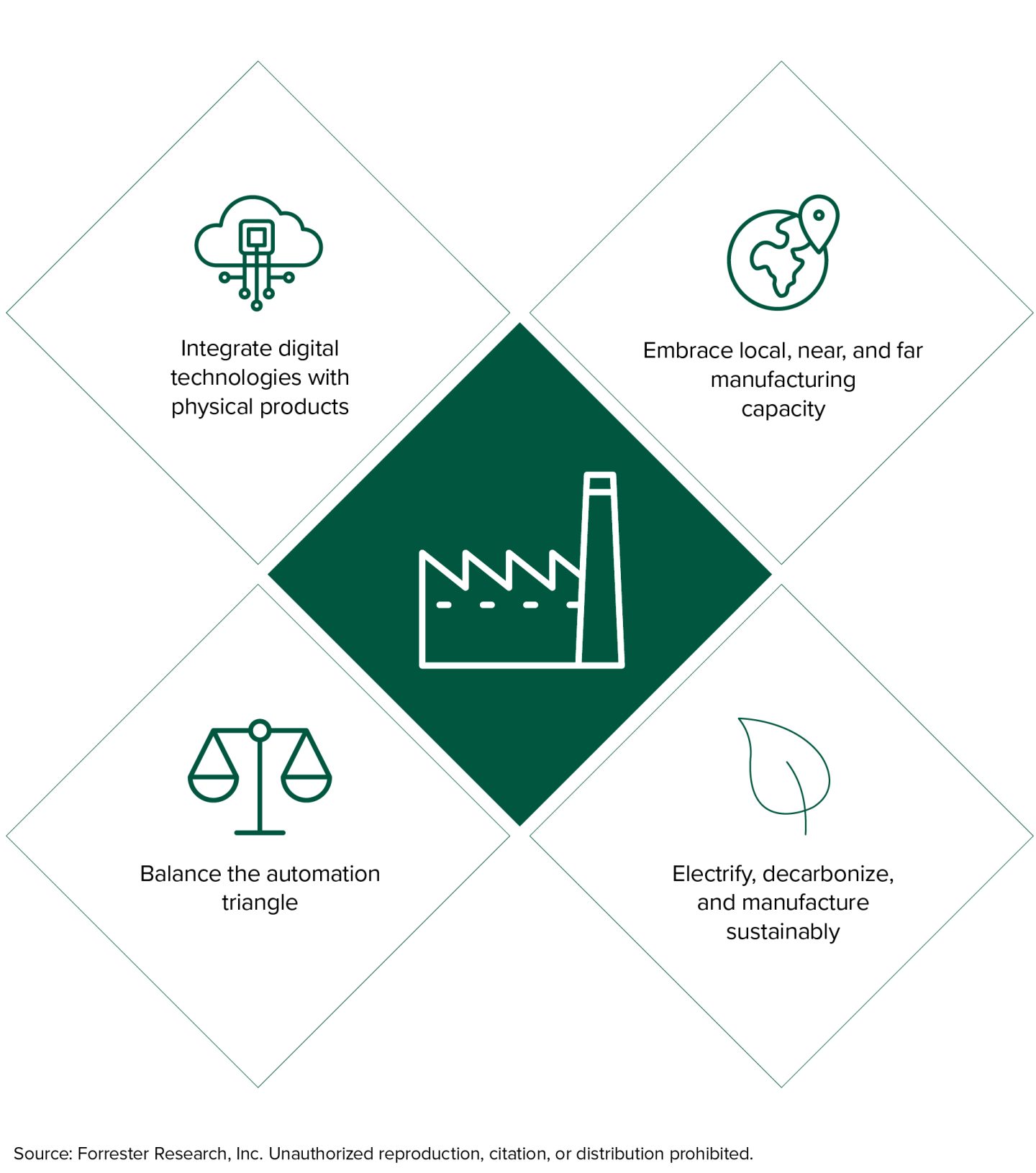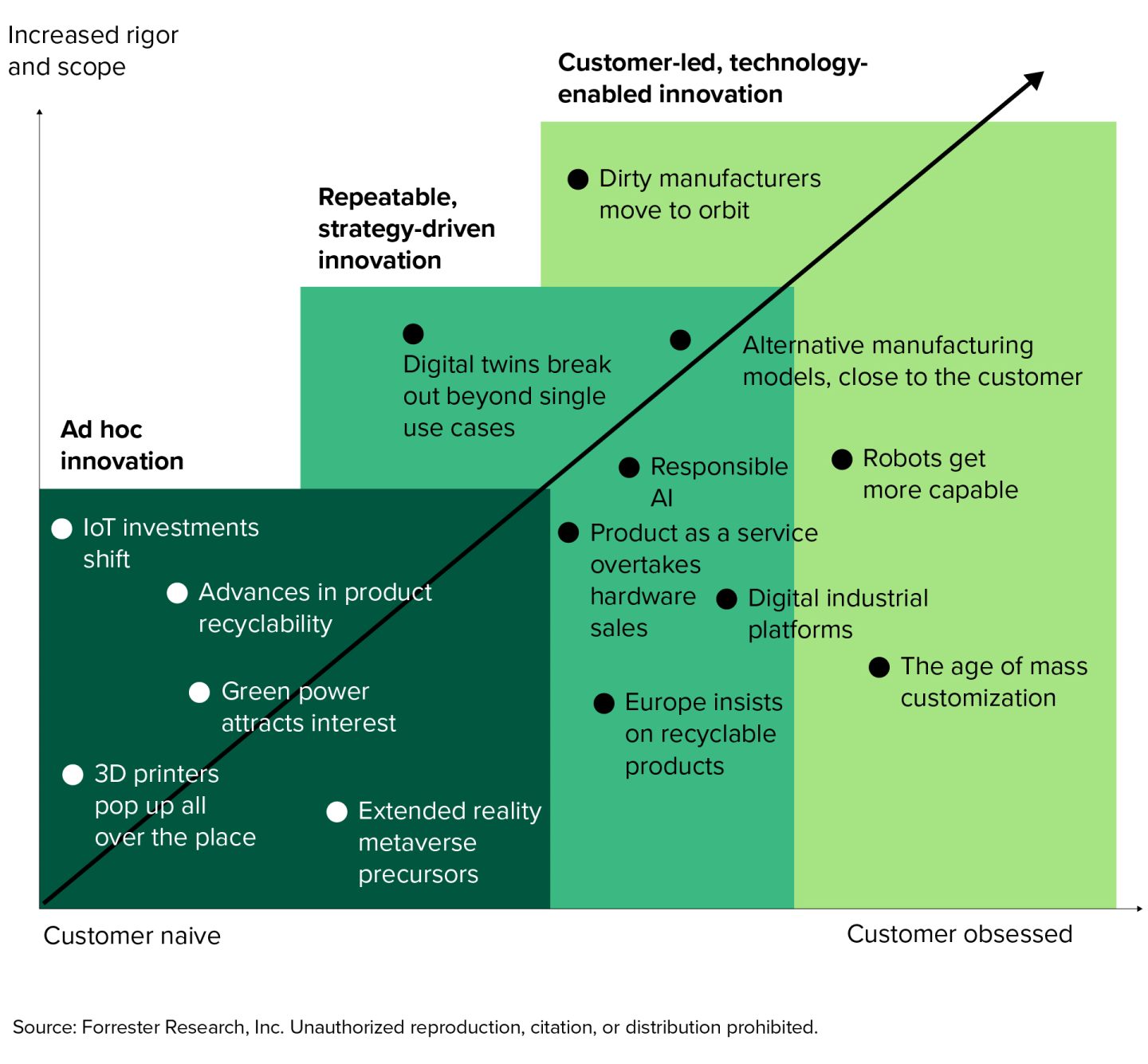What is the future of manufacturing?
A Forrester Research report shows how disruptive innovations in manufacturing will reshape entire industries.

Manufacturers who want to compete in an increasingly volatile market know that they must become quicker, smarter, and greener to survive. That is a key finding of Forrester Research’s report, The Future of Manufacturing, which analyzes the manufacturing market and identifies major trends affecting the industry — plus ways technology executives can respond effectively using IoT solutions and other technology clusters.
The good news for manufacturers is that despite the scale of the challenge, there are many ways to take advantage of new opportunities — whether you are looking at changes on the immediate horizon or sustained initiatives that might span a decade.
Unsurprisingly to any executive engaged with smart manufacturing and Industry 4.0, digital technologies play a pivotal role in the transformation. And among new technologies, Industrial IoT capabilities stand out for the range of applications and capabilities they offer, from enhancing operational efficiency to building new business models.
Before deciding on technology investments, it’s important to understand the four big trends Forrester Research says are already reshaping manufacturing:
- Integrating digital technologies with physical products, combining grease with code. Digital capabilities augment physical products. Building smart, connected products enables manufacturers to design, build, sell, use, reuse, support, and value them in new ways.
- Adapting to a changing world order with local, near, and far manufacturing capacity. Forward-looking manufacturers are moving away from long and brittle supply chains to embrace more flexible and resilient supply networks, which combine the cost benefits of offshore manufacturing with the speed-to-market and political benefits of moving jobs closer to customers.
- Electrifying, decarbonizing, and then manufacturing sustainably. Despite the fact that manufacturing and construction, electricity supply, and transport services make up the majority of greenhouse gas emissions in the EU1, most firms are just getting started on serious programs to manufacture more sustainably. This will require them to make decisions about the source, nature, and use of energy and raw materials, while cutting waste, improving efficiency, and moving toward a more circular economy.
- Balancing the automation triangle to get the best from hardware, software, and people. Far from replacing human workers, well-developed hardware and software automation augment them, extend their reach, and take up some of the slack in today’s challenging labor market.
Figure 1: Four big trends shape the future of manufacturing

In the face of these pressures, manufacturing firms must do more than just making existing physical processes more efficient. Instead, you must transform your business into a future-fit organization that is adaptive, creative, and resilient. In addition to improving manufacturing operations and equipment performance with technologies, new approaches can also help you to unlock more sustainable and profitable customer relationships.
How IoT helps power the future of manufacturing
The sheer number and varieties of new technologies involved in manufacturing’s future — and the ways they can be applied alone or in synchronization — can be daunting, even to technology decision-makers who embrace change.
Figure 2: Three innovation horizons define the future of manufacturing

Among all the technology clusters available, IIoT stands out as one of the most versatile and adaptable technology strategies. This is true for manufacturers with a focus on the immediate future, working to deploy ad hoc innovations that improve existing processes and workflows. It’s equally true for those who are learning lessons from initial innovations, aligning them to corporate strategy, and making them repeatable at scale over the course of 5-10 years.
Let’s take a closer look at the ways you can deploy IoT solutions:
1. Reducing energy bills and accelerating sustainable manufacturing.
As the cost of energy spikes, manufacturers are repurposing existing investments in IoT for sustainability: to deliver actionable data on the connection between energy and production, supporting strategic initiatives to cut waste, and boost useful output per kilowatt consumed.
As an example, take GreenFlex. For over 12 years, GreenFlex has been supporting companies and territories in all their sustainable development, decarbonization, and energy efficiency issues. The company uses the Cumulocity IoT platform to power device connectivity, device management, and data collection for GreenFlexIQ, it’s digital platform for managing action plans. Using this IIoT solution, GreenFlex can monitor and control devices on thousands of devices at customer sites so it can gather data and take actions to hit efficiency targets. It’s a great example of the ways IIoT can bring sustainable development, decarbonization, and energy efficiency projects to life.
2. Building digital twins — and the foundation for the industrial metaverse
Digital twins are a digital representation of a physical object’s data, state, relationships, and behavior. Today, companies are using mixed-reality headsets to monitor operators’ interaction with features for products. Other collaborate remotely using digital twins of the industrial robots they manufacture and maintain.
Today, a world-leading wind turbine manufacturer uses digital twins with Cumulocity IoT to manage remote equipment, each consisting of up to 100 controllers, across many networks. Digital twins help them manage their dispersed assets remotely from a single dashboard to monitor equipment condition and assure quality.
As the technology matures, digital twins are starting to break out beyond single use cases. Technical advances and the breakdown of organizational silos will finally lead to digital twins that realistically follow the digital thread from product design to manufacture, use, and disposal to unlock efficiencies, insights, and customer relationship enhancements. In doing so, these digital twins will enable you to create solutions around business assets instead of IoT devices.
3. Powering new product-as-a-service revenue to overtake hardware sales
As connectivity, compute, and sensors become cheaper, more manufacturers have begun to explore shifting from selling hardware to delivering services, a scenario often titled product servitization, Equipment-as-a-Service, or Product-as-a-Service. Many manufacturers will see more service than product revenue by the end of this 10-year period.
Research firm IoT Analytics projects the Equipment-as-a-Service (EaaS) market will be $131 billion in 20252, with a CAGR of 35% starting in 2019. Already, machinery companies that combine hardware, software, and services have 8x greater total shareholder return3, compared to laggards in their sectors.
Consider how WAINS, a digital-first pest detection company, uses IoT to move the physical detection of insects into the cloud. With a solution powered by Cumulocity IoT, WAINS gives its pest control business users a customized, smart solution to serve their end-user customers. These services, including remote monitoring and environmental modeling, generate recurring revenue and enable WAINS to build stronger relationships with its users.
To build your future with IoT-enabled capabilities and business models, manufacturers will have to take it one step at a time. Fortunately, there’s value to be had at every step of the IoT maturity curve.
Want to learn more? Learn more about IoT in manufacturing to prepare for your organization’s digital transformation — then start taking steps to build its future.
1Eurostat: Eurostat releases for the first time estimates of quarterly EU greenhouse gas emissions
3Bain & Company: Thinking Outside the Machine, Global Machinery & Equipment Report 2022